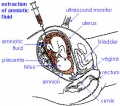Neonatal Diagnosis: Difference between revisions
| Line 61: | Line 61: | ||
Neonates born with congenital hypothyroidism (CH) typically have a normal appearance and no detectable physical signs. Thyroid hormone is required for normal postnatal neural (cognitive) development with newborn screening and thyroid therapy able to be begun within 2 weeks of birth. | Neonates born with congenital hypothyroidism (CH) typically have a normal appearance and no detectable physical signs. Thyroid hormone is required for normal postnatal neural (cognitive) development with newborn screening and thyroid therapy able to be begun within 2 weeks of birth. | ||
The availability of a universal screening program for this hormonal abnormality varies from country to country.<ref> | The availability of a universal screening program for this hormonal abnormality varies from country to country.<ref><pubmed>16740880</pubmed></ref> | ||
Congenital hypothyroidism can occur through either dysgenesis or agenesis of the thyroid gland development or abnormal thyroid hormone production. A false positive high thyroid stimulating hormone (TSH) can occur, due to the neonatal TSH surge that elevates TSH levels and causes T4 and T3 changes in the first 1 or 2 days after birth. | Congenital hypothyroidism can occur through either dysgenesis or agenesis of the thyroid gland development or abnormal thyroid hormone production. A false positive high thyroid stimulating hormone (TSH) can occur, due to the neonatal TSH surge that elevates TSH levels and causes T4 and T3 changes in the first 1 or 2 days after birth. | ||
Revision as of 09:17, 15 June 2010
Introduction
In the early 1950's Virginia Apgar published the research article that was the basis of a simple diagnostic test, the 10-point Apgar score, for neonatal well-being at birth that continues to be used today.
There are a number of different neonatal screening (newborn screening) programs in different countries testing for various "common" abnormalities and infections. In addition to the Gutherie test there are also physical tests for hip displasia and a growing number of countries testing of newborn hearing.
Neonatal Diagnosis Links: APGAR test | Guthrie test | Hearing test | Electrocardiogram (ECG/EKG) | Tandem mass spectrometry
Diagnosis Categories
- Prenatal diagnosis - number of different techniques (non-invasive, invasive) for determining normal development
- Neonatal diagnosis (APGAR test, Guthrie test)
- Maternal diagnosis - often pregnancy will expose maternal health problems
- Gutherie card icon.jpg
Gutherie card
Routine Screened Disorders
Biotinidase Deficiency (OMIM)
Congenital Adrenal Hyperplasia (CAH) (OMIM)
Congenital Hypothyroidism (CH)
Congenital Toxoplasmosis
Cystic Fibrosis (CF) (OMIM)
Galactosemia (GAL) (OMIM)
Homocystinuria (OMIM)
Maple Syrup Urine Disease (MSUD) (MCAD | OMIM)
Medium-Chain Acyl-CoA Dehydrogenase Deficiency (MCAD) (OMIM)
Medium-Chain Acyl-CoA Dehydrogenase Deficiency (MCAD)
MCAD deficiency is the most common inherited disorder of mitochondrial fatty acid oxidation in people from northern Europe. It is characterized by an intolerance to prolonged fasting and an inability to generate energy during periods of increased energy demand. The disorder can be severe to fatal in infants.
The other disease characteristics include: recurrent episodes of hypoglycemic coma with medium-chain dicarboxylic aciduria, impaired ketogenesis, and low plasma and tissue carnitine levels.
Gutherie test detected autosomal recessive metabolic disease affects about one in 10 000 people (UK). This mitochondrial protein is encoded by a nuclear gene on chromosome 1 (Gene map locus 1p31) and has a common mutation (985A>G) with a carrier rate of around one in 65.2.
Tandem mass spectrometry
Tandem mass spectrometry (MS/MS) - can screen for PKU and many other diseases simultaneously (up to 21 metabolic diseases).[1]
Endocrine
Congenital Hypothyroidism
Neonates born with congenital hypothyroidism (CH) typically have a normal appearance and no detectable physical signs. Thyroid hormone is required for normal postnatal neural (cognitive) development with newborn screening and thyroid therapy able to be begun within 2 weeks of birth.
The availability of a universal screening program for this hormonal abnormality varies from country to country.[2]
Congenital hypothyroidism can occur through either dysgenesis or agenesis of the thyroid gland development or abnormal thyroid hormone production. A false positive high thyroid stimulating hormone (TSH) can occur, due to the neonatal TSH surge that elevates TSH levels and causes T4 and T3 changes in the first 1 or 2 days after birth.
See also Iodine deficiency.
Gene Tests
A new site developed by NIH "GeneTests" provides medical genetics information resources available at no cost to all interested persons. It contains educational information, a directory of genetic testing laboratories and links to other databases such as OMIM.
Links: Gene Tests
References
Search PubMed: neonatal diagnosis | neonatal screening
Glossary Links
- Glossary: A | B | C | D | E | F | G | H | I | J | K | L | M | N | O | P | Q | R | S | T | U | V | W | X | Y | Z | Numbers | Symbols | Term Link
Cite this page: Hill, M.A. (2024, May 2) Embryology Neonatal Diagnosis. Retrieved from https://embryology.med.unsw.edu.au/embryology/index.php/Neonatal_Diagnosis
- © Dr Mark Hill 2024, UNSW Embryology ISBN: 978 0 7334 2609 4 - UNSW CRICOS Provider Code No. 00098G





